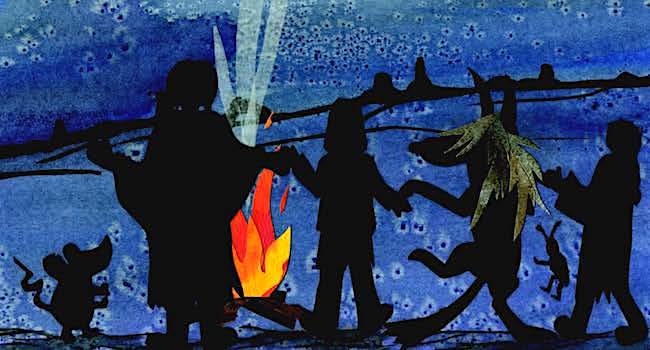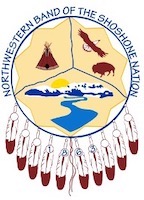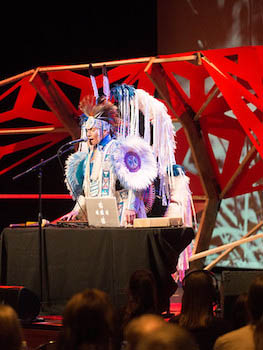SUBJECTS
GRADE
Show Results
Coyote Steals Fire: Creative Movement

Lesson Summary
- Explore movement in connection to an origin tale.
- Learn how Native American cultures preserve their stories.
Lesson Plan and Procedure
Lesson Key Facts
- Grade(s): 1, 2, 3
- Subject(s): Dance, English Language Arts, Social Studies, Native American, Tribe Approved
- Duration of lesson: 30 - 35 minutes
- Author(s): Patty Timbimboo-Madsen and Rachel Marie Kimball

The Northwestern Band of the Shoshone Nation selected this lesson content in answer to the question, “What would you like the students of Utah to know about you?” Patty Timbimboo-Madsen, the NWBSN History and Culture Specialist, represented the Northwestern Band of the Shoshone Nation in crafting the lesson to provide expertise, accuracy, and authenticity.
Before teaching this lesson, please explain to your students that there are many Native tribes in the United States and that this lesson specifically focuses on the Northwestern Band of the Shoshone Nation and does not represent other Native American groups. We hope that other Native tribes will respect the Northwestern Band of the Shoshone Nation's choice to share this aspect of their culture.
Behavior Expectations
Stay within set boundaries throughout the activity. Remove any loose footwear (or instruct all students to remove footwear). Establish a signal for students to respond to when starting/stopping a movement experience (for example, drum, clap, call and response).
Behavior I CAN Statements:
- I can explore movement without talking.
- I can stay in my own space (following my own pathways and ideas).
- I can listen to and follow instructions.
Behavior with scarves: Before passing out scarves, explain that they are a tool, not a toy, and we must respect the scarves and others as we use them. As a student receives their scarf, they need to quickly put it in their lap or on the floor in front of them, show that their hands are free, and look at you for more instruction. “Put your scarves in your laps, hands free, looking at me!”
When gathering students for instruction during the lesson, have them sit in a circle formation.
Introduction
(2 minutes)
Introduce the story Coyote Steals Fire by explaining that it is a Native American origin tale, a story that explains how things came to be. This story is shared among different tribes, and today’s variation comes from the Northwestern Band of the Shoshone Nation, located in modern day Utah. In this variation of the tale, we learn about how fire came to be shared in the four directions. Explain that in the oral tradition, it is customary for the Northwestern Shoshone to tell stories during the winter. In keeping with this tradition, if possible, teach this lesson in the winter (first snow to first thunder). Instruct students to pay attention to the characters and lessons from this story.
Exploration/Skill Development/Create/Perform
(20-30 minutes)
Watch a minute of this outdoor fire video to help students observe the way fire moves and dances.
Provide each student with a scarf (optional, as this lesson can still be done without a scarf), and take a minute to explore the way fire moves. Ask students to help provide descriptive words to prompt movement. Play music quietly in the background as you discuss fire and explore movement for it. (See music selections under Materials.)
Teacher: [With our scarves], let's explore a few movements related to fire. What are some words you can think of to describe the way  fire moves or appears? (Possible answers: strong, swirling, reaching, wiggly, sparks, chaotic, energetic, fast, spinning, stretching, explosive.)
fire moves or appears? (Possible answers: strong, swirling, reaching, wiggly, sparks, chaotic, energetic, fast, spinning, stretching, explosive.)
Read the book Coyote Steals Fire by the Northwestern Band of the Shoshone Nation prior to exploring the rest of the movement lesson and/or during the movement lesson.
Identify the main characters and elements in Coyote Steals Fire, adding movement to each one. Invite students to use their scarves creatively.
Movement Ideas
Animals--shivering, cold, low level, slow
Teacher: Using your scarf and various body parts, how can you show shivering, vibratory movements? Can you demonstrate shivering, vibratory movements on a low level? How can we show the cold through slow movement?
Fire--swirling, stretching, spinning, sparks
Teacher: Explore fiery movements with your scarf and your body!
Landscape--pine (tall prickly shape), pinyon (low prickly shape), mountain (straight and bent lines and shapes), desert (cactus shape)
 Teacher: Create a tall, prickly shape like a pine tree. Now slowly change to a similar prickly shape but on a lower level like a pinyon tree. Next, create (on your own or with others) a jagged mountain shape. Now slowly change into a cactus shape to represent the desert.
Teacher: Create a tall, prickly shape like a pine tree. Now slowly change to a similar prickly shape but on a lower level like a pinyon tree. Next, create (on your own or with others) a jagged mountain shape. Now slowly change into a cactus shape to represent the desert.
Optional: Instruct ½ of the class to create pine tree shapes and mountain shapes in one part of the classroom. Guide the other ½ of the class to create pinyon tree shapes and cactus shapes in the other part of the classroom. Invite a few students to take turns dancing through both parts of the classroom to experience the different landscapes that their classmates created.
Note: For those in Utah county, you are actually on the ancestral lands of the Ute, Shoshone and Paiute.
Coyote--clever, sneaky, smooth
Teacher: Explore different ways to move carefully and sneakily through the space. Try moving big and small, high and low, but very quietly! Now, I'm going to close my eyes as you continue moving for about 10 seconds, and let's see how quietly you can surprise me by where you end up after 10 seconds!
Round Dance--traditional social dance of Native peoples in the United States
If you have students of Native American descent in your class, invite them to lead the round dance with you (even if they don’t know the round dance themselves). It is important to consider inviting a friend of Native American descent to lead this dance during this lesson or on a different day.
Porcupine--poking/jabbing arms and legs (prickly quill dress)
Teacher: How can you move your body in sharp, prickly, jabbing ways like Porcupine's quill dress?
Stinkbug--jumping, hopping, high levels and low levels
Teacher: How can you show off your jumps like Stinkbug? Can you jump and hop down low and up high?
Dancing All Night--Free Dance :)
Teacher: Since the animals and people danced all night, let's take a moment to have our own Free Dance party!
Turn on a fun song and allow students to dance in their own ways. The Shoshone dance their traditional dances, yet we are going to use creative movement to explore our own ideas. Help students avoid imitating stereotypical Native dances.
Packrat--running (in place) (hold scarf/“fire” under belly)
Teacher: Coyote threw the fiery wig to Packrat, so practicing tossing your scarf in the air a few times and catching it! Now, hold your scarf near your belly like Packrat and run quickly in place!
Coal to Fire--small shape like tiny coal, then move to combined class shape like fire. Choose from the two options below.
Teacher: Scrunch up your scarf in both of your hands. Next, as you slowly blow on your hands, gently open your hands and watch the scarf expand, like a fire coming to life. Let's put all of our scarves together in the middle of the space like the coals of a fire, and then sit around it in a big circle.
Teacher: Create a small shape with your body like a small piece of coal. When I say "GO!", move your coal shape (your body) to the middle of the space to join the rest of the class, and then swirl your scarf around like a fire coming to life! 
Directions--make unique shapes or movements facing North, East, South and West
Leaving the scarves in the middle of the space and sitting in a circle around the scarves, identify where North, East, South and West are in relation to the room you’re in. Then, using reaching motions with your arms and moving in unison as a class, imagine you are placing fire in the North, the South, the East and the West--the four sacred directions.
Optional: If time allows, assign certain characters/elements to small groups and instruct them to create their own movement to go along with the assigned character/element. Then go through a summary of the story again and have small groups perform their movement when it comes to their part.
Cool Down/Discussion
(2 minutes)
After a brief cool down (stretching and breathing), guide students through a brief discussion about what they learned from this lesson:
Teacher: What can we learn from this Shoshone story? What did you notice about the characters in the story? What was your favorite movement to perform/explore during this lesson?
For Fun
Another tribe that also tells a variation of how Coyote steals fire is the Crow Indian Tribe. In this video clip, a well known Native American musician and dance artist of the Crow Indian Tribe named Christian Parrish Takes the Gun who goes by Supaman, shares his talents and culture through song and dance. Be sure to explain that by wearing his traditional fancy dance regalia, he combines traditional culture with modern arts. Supaman is a motivational speaker and artist who helps youth to be proud of their own identity and roots. Following the video, discuss how stories and traditions can be passed on through music and dance.
Assessment
Observe how well students are able to explore and perform the movements throughout this lesson as well as the way they respond to discussion questions at the end of the lesson.
Vocabulary
Art Form
Prop: scarves (a tool, not a toy)
Energy: sharp and smooth
Levels: high and low
Axial Motion: poke, swirl, spin, wiggle, shake, grow, shrink
Locomotor Motion: walk, run, jump, hop
Content Area
Northwestern Band of the Shoshone Nation
Cultural Story
Characters
Learning Objectives
- Find lessons, morals, or central messages from diverse cultural stories.
- Reflect on movement choices and change the movement through guided improvisational experiences or short remembered sequences.
- Reflect on and change movement choices through guided improvisational experiences based on diverse cultural stories.
Utah State Board of Education Standards
This lesson can be used to meet standards in many grades and subject areas. We will highlight one grade’s standards to give an example of application.
Grade 2 Dance
- Standard 2.D.CR.2: Explore movement inspired by a variety of stimuli.
- Standard 2.R.12:Demonstrate understanding of story elements and/or topics by applying information gained from illustrations or text features. (RL & RI)
Grade 2 English Language Arts
- Standard 2.R.6: Read a variety of texts including those from diverse cultures, retell the narrative (RL) or informational text (RI) according to the text structure including the main idea.
- Standard 2.R.12: Demonstrate understanding of story elements and/or topics by applying information gained from illustrations or text features. (RL & RI)
Grade 2 Social Studies
Strand 1: History: Students use historical thinking skills to explore continuity and change in their community, Utah, and the United States.
Standard 2.1.1: ...Document the chronology of important events in their personal, family, school, local, or broader community history (including three significant events).
Standard 2.1.2: ...Identify how their community has changed or remained the same over time, and make inferences about the reasons why.
Standard 2.1.5: Identify the achievements of significant Americans, including those from local and other diverse perspectives, and explain their importance.
Equipment and Materials Needed
- Coyote Steals Fire from the Northwestern Band of the Shoshone Nation
- Prayer Loop Song by Supaman (Crow Artist)
- Scarves (optional)
- Music Selections:
- Fire Dance by rensmusic
- Natives by Rene Sans
- The.Way.it.Was by Greg Reiter
- Dance.of.the.Hummingbird by Greg Reiter
Additional Resources
This lesson was created thanks to a grant from the National Endowment for the Arts and the Utah Division of Arts & Museums.
- Patty Timbimboo-Madsen’s short video about storytelling
- Rios Pacheco’s short video about storytelling
Image References
Image 1: https://digitalcommons.usu.edu/usupress_pubs/81/
Image 2: Northwestern Band of the Shoshone Nation
Image 3: https://digitalcommons.usu.edu/usupress_pubs/81/
Images 4, 5: Brenda Beyal
Image 6 : "Supaman" by TEDxBozeman is licensed under CC BY-NC-ND 2.0
© Brigham Young University and the Northwestern Band of the Shoshone Nation

www.education.byu.edu/arts/lessons
 Download
Download